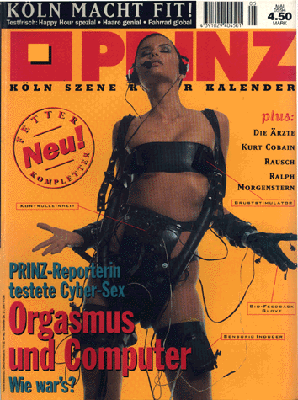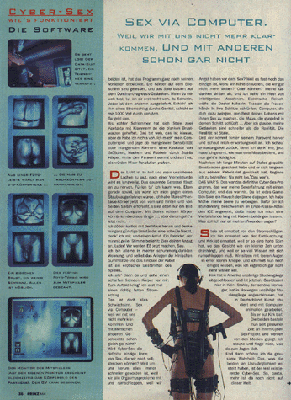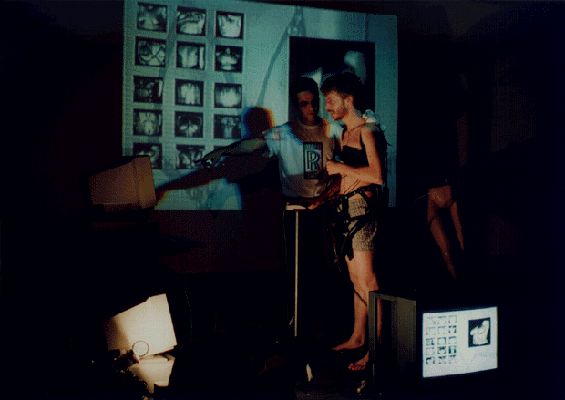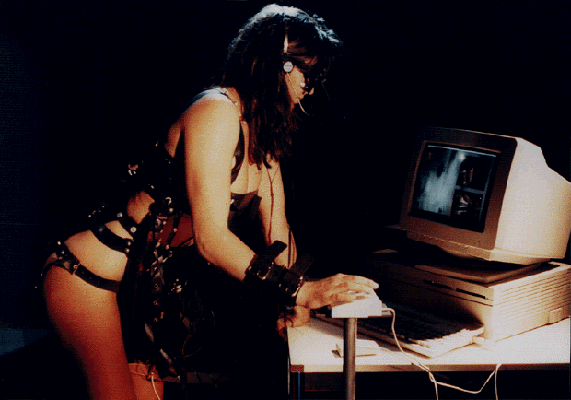CyberSM, The 2nd Experiment, 1993-94
CyberSM™
Stahl Stenslie and Kirk Woolford
1993-1994
CyberSM was based on Sado-Masochistic role playing, after all, V.R. equipment has always looked similar to S&M fetish fashion. The first motion tracking suit was a full-bodied black leather suit covered with shiny chrome plates. Through the CyberSM system, participants built a virtual body linked to their own body. They then handed this virtual body, and to a degree, control of their physical body to the other participant while gaining control of the other participant's body. The CyberSM system included two suits worn by the participants, a database of 3-D scans used to build the virtual bodies and 2 computers connected with international ISDN telephone lines. Once the participants put on one of the suits, they built a virtual body by picking from the database. When ready, the computers exchanged these proxies, and each participant received the other participant's body on the screen in front of them. By rotating and zooming the virtual body, participants could place pointer over regions of the virtual body. When the participant clicked a button, the computer transmitted this "touch" over the ISDN lines to the owner of the virtual body. The remote computer translated this "touch" into a physical impulse (vibration or electric shock) generated by the remote participant's suit. In order to give a greater sense of the other person's presence, we included a voice connection between the sites, allowing participants to speak to each other. We quickly learned that transmitting a single touch, even one so strong as an electric shock, was no match for the com'munications abilities of a telephone. The system functioned amazingly well as long as both participants spoke the same language. However, during the first exhibition of CyberSM, we had a participant in Paris who spoke only French, and a participant in Cologne who spoke German and English. After they pushed a couple buttons, and mumbled to each other, they got bored and asked somebody to take the "silly suits" off them. I then realized that we had created method of illustrating a telephone conversation with touch. The project allowed people to "touch" each other over a network, but the form of the touch was too limited to allow them to carry on a dialogue. They fell back upon the skills they learned through years of talking on telephones.
In order to create a more fulfilling touch over a network, Stahl and I began work on CyberSM III. Aside from many technical changes, CyberSM III changed the interface from a pointer and model of the body, to the physical body as an interface itself. In CyberSM III, the participants touched their own bodies in order to touch the other participant. The suits built for CyberSM III included various touch zones. When the participant touched one of these zones, their computer measured how long the zone was touched and translated this into an intensity for the stimulation at this point. To further enhance the sensation, CyberSM III, stored the last three touches and played all three out simultaneously through The CyberSM projects, confronted not only problems of using the human body as an interface, but cultural perceptions of touch as well. The first, and most obvious cultural problem is our relationship to touch between two people. Because the most common touch between people, indeed for many people, the only touch between people, is sexual, CyberSM was immediately named the first functional cybersex system, and magazines and television programs were full of the distorted capabilities of the amazing CyberSM system ("4,ooo volts of electricity pulsing up and down your legs," claimed one magazine). However, aside from the media hype, everyone who tried on the suits agreed they were interesting, but far from fulfilling. The suits could only control a very limited number of stimulators, so we placed these stimulators on either the most sensitive regions of the body, or regions which best fit the construction of the suit. When we touch each other, the location and quality of the touch convey more meaning than the simple act of touching. The suits design never allowed this kind of subtlety.
------------- original press release, Dec 1993 -----------------
CyberSM™
the second experiment
1993-1994
The cyberSM™ project is an attempt to create a real time, visual, auditory, and tactile communication in the world of cyberspace. In this cyberSM™ experiment, the user begins to experience what others have only talked about for years: live, tactile communication through a computer environment. CyberSM expands upon text based virtual environments, such as Minitel, MUDs, or most BBSs. It takes the next logical step toward true telepresence by employing 3D graphics, live audio, and direct physical stimulation to allow participants to “touch” each other over physical distances.
At the heart of the cyberSM™ project is the ability to transmit physical stimuli from one participant to the other. This is done through the use of stimulator suits connected over international telephone lines, which allow the users to remotely stimulate one-another's bodies. Not only does this physical element of communication allow the CyberSM project to more closely model inter-human communication, it creates a new form of interaction. Throughout the project, participants have a physical dialogue, but they remain anonymous the whole time.
Before beginning the dialogue the participants build “virtual bodies” by chosing from a databank of pre-scanned models. They can rotate the bodies, zoom in or out, and mix pieces from any gender. Once the body is built, the participant can preview how they will appear to the participant at the remote site. They can test their suit and, when both sites are ready, connect to the remote site. The local participant’s virtual body is then sent to the remote participant’s computer, where it will be used as the interface for the local participants suit. Once connected, the participants can speak to each other over a custom built speaker phone, and control each other’s suits through interactions with the virtual bodies. The participants are presented with each other’s virtual bodies on the monitor or projector before them. By exploring and touching each other’s virtual bodies, they can physically touch one another through the network.
The cyberSM project, makes communications technology transparent. It allows us to extend our physical perceptions over distances, through computer neworks, and beyond cyberspaces. Not only can we reach out and touch people who aren't there, we can touch people who are there in ways not physically possible.





